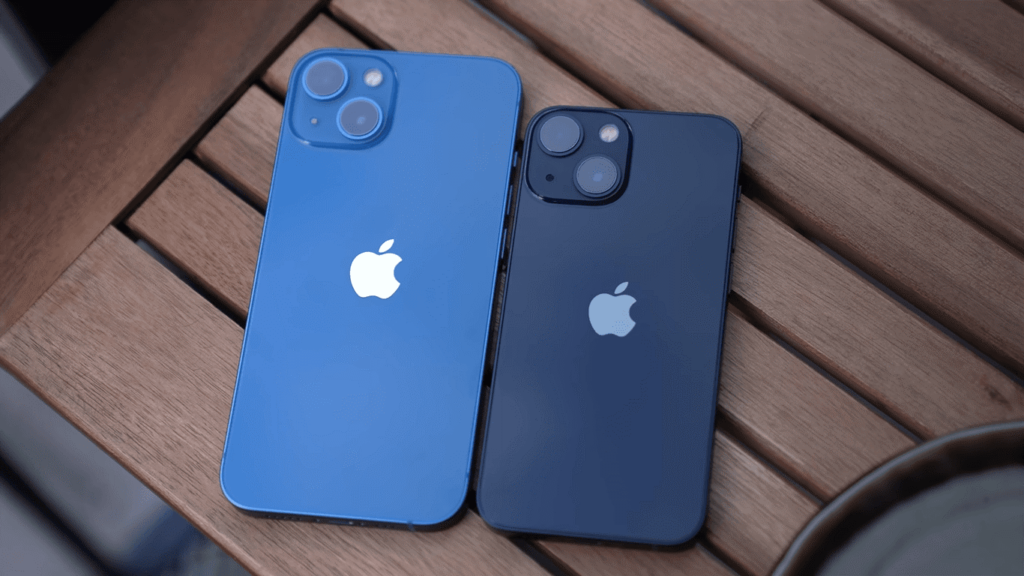
The specifications of the iPhone 13 phone may not seem exciting to some, especially if they are followers of the latest news on Android phones. The improvements that the new Apple phone has received do not constitute radical updates, but they are valuable additions to last year’s phone, on top of which is giving the iPhone 12 Pro Max camera features to the iPhone 13 phone. iPhone 13 is smaller and cheaper, while improving battery life, processing power and others can be considered regular periodic improvements. All of these new updates combine to make a phone worth upgrading if you are using an old iPhone. As for users of last year’s phone, this year’s phone will not be able to provide what drives them to buy a new phone.
iPhone 13 design
Apple maintained the design and shape of the phone last year, with the only difference being the size of the notch dedicated to the front camera and FaceID sensors, which became 20% smaller. This change may seem obvious the first few times you hold the phone, but you quickly get used to ignoring The entire notch during use.
iPhone 13
There are also some slight changes that you may feel when using the phone, as the weight of the phone has increased by 10 grams compared to the weight of the phone last year, and the rear cameras are now located diagonally after it was placed vertically, this may be due to the size of this larger camera sensor The year, which requires more space, or perhaps just a design change, without which it is impossible to distinguish between the iPhone 12 and iPhone 13 from the back.
Apple preferred to use aluminum instead of stainless steel in the side frame of the phone to distinguish the regular version from the more expensive Pro version, but I personally prefer the matte aluminum look that is less affected by smudges and fingerprints.
The phone supports the IP68 protection standard, making it resistant to dust, dirt and immersion in water for 30 minutes at a depth of 6 meters, and the front is covered with “Ceramic Shield” glass that Apple introduced for the first time in the iPhone 12. The company says that the new glass provides four times greater protection than the glass used in older phones.
iPhone 13
iPhone 13 screen
The iPhone 13 comes with a 6.1-inch Super Retina XDR OLED screen, similar to the screen size of its predecessor, the iPhone 12; But unlike the larger and more expensive Pro version that supports a fast refresh rate of 120 Hz, the screen of the regular phone comes with a refresh rate of only 60 Hz.
The screen supports HRD10 and Dolby Atmos technologies, and its brightness is 800 nits, and it can reach 1200 nits in automatic mode. The screen resolution is 1170 x 2532 with a pixel density of 460 pixels per inch, and although it is not the brightest or most accurate screen, it is more than enough for normal daily use.
iPhone 13
iPhone 13 camera
At first glance, the rear cameras may not seem to have received any improvements this year, as the main camera is 12 megapixels and the secondary wide-angle 12 megapixels as well, but the real strength lies in the details.
Although the numbers are the same, the iPhone 13 phone got a completely new camera system, as the company gave the camera of its new phone a larger sensor, and doubled the size of one pixel to 1.7 micrometers (compared to 1.4 micrometers in the iPhone 12 camera). This enables the camera to capture a larger amount of light and thus significantly improves image quality, especially with the ultra-wide f/1.6 aperture.
The main camera also inherited the optical stabilization technology from the iPhone 12 Pro Max, which the company calls “Sensor Shift OIS”, and this technology enables you to take clear pictures even if you are not able to keep your hand steady while taking pictures.
iPhone 13
As for the wide-angle camera, it has an f/2.4 lens and a 120-degree viewing angle, which is suitable for capturing a wider scene that the main camera angle cannot capture. Although the quality of the pictures taken with the wide camera has improved, it is not up to the quality of the pictures of the main camera.
It was not only the physical hardware of the cameras that got the upgrade, but the camera app also got new features, the most important of which is the “Photographic Style” that enables you to apply certain settings to the captured photos in a filter-like fashion, but it is not at all! This technology allows applying adjustments to different elements of the image, unlike normal filters that apply the effect to all parts of the image in full, in addition to some fundamental differences that I will not touch on in order to avoid the idea of revision. This feature is more useful if you prefer a specific shooting style, but it won’t be a feature you find yourself using all the time.
The app has also got a cinematic video recording mode that allows the bokeh effect to be applied to the videos as well. In other words, the new mode enables you to focus on a specific object and blur the rest of the scene in a similar way to cinematography used to focus on a speaker’s face or draw viewers’ attention to a specific subject.
iPhone 13 performance
Apple supplied the iPhone 13 with its new A15 Bionic processor, in an attempt once again to provide the most powerful smartphones in the market, and this is what it has always done throughout the competition with Android phone processors.
The company stated that its new chip’s CPU is 50% faster and its GPU is 30% faster than last year’s A14 Bionic chip, which was essentially the fastest chip ever used in a smartphone.